Testing Tools 2012 at the Shenkin Garden and Beit Tami, August 7-9
This is a guest post by Meredith Nadler.
“Testing Tools – Festival of Art in the Making,” an experimental arts festival in its ninth edition this year, offered audiences an intimate view of both visual and performing arts from a wide array of genres, styles and mediums. The festival, which featured over 20 theater and dance pieces and over 40 works of visual art, utilized every possible space – including playground, bathrooms and even elevator. Although impressed by the sheer volume of activity, after understanding that the festival provided no remuneration to the over 100 participating artists, I was hesitant to set my expectations too high concerning the professionalism of the work programmed. However, I was very pleasantly surprised by the quality and innovation of many of the pieces I saw.
Untitled Mural by Yael Balaban and Hadas Reshef. Photo by Yuri Divinsky.
Gil Alon, artist director of the festival, explained, “We wanted to focus on the artists’ creative process. Works that were curated tend not to be finished pieces, but rather works in progress which have been substantially developed and are presented here in their later stages of creation.” Curator Carmit Blumensohn selected works that often took the form of a veritable laboratory, evident in the site specific installation Metabolism by Nivi Alroy and Hila Amran. Or whose actual content clearly evoked genesis and transformation, such as with artist Uri Shapira, who used stop motion and time lapse techniques to create ever-changing landscapes akin to cellular regeneration. Then there was the real life action-painting that took shape over the course of the festival outside at the entrance of the Shenkin Garden by Yael Balaban and Hadas Reshef. Juxtaposing their divergent styles – the former subdued, meditative and precise, the other, a riot of color and cartoon-like proportions – the crowds could watch their mural unfold before their eyes as the two artists worked throughout the festival’s three days non-stop, pausing only for artistic contributions of kids armed with markers and by Tel Aviv’s Mayor himself.
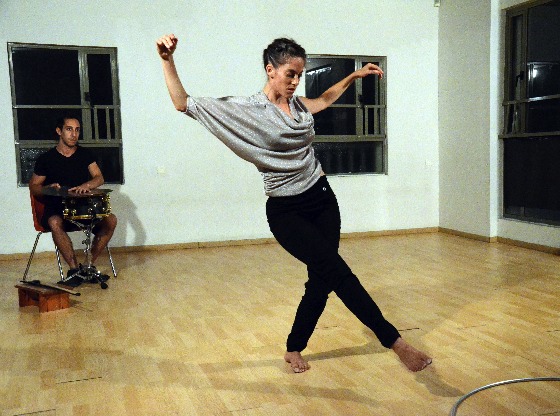
Carrying Him Circling Her. Duet by Sharon Attinson and Ofer Bymel. Photo by Yuri Divinsky.
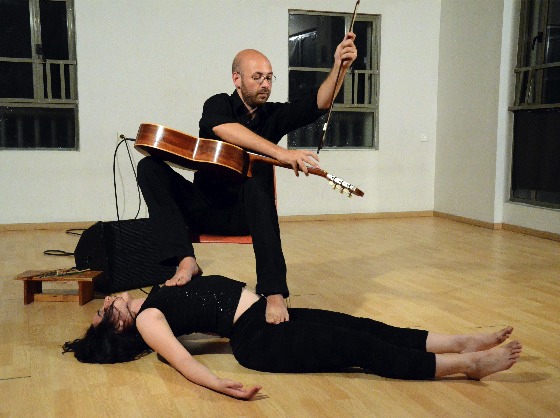
Carrying Him Circling Her. Duet by Avigail Sfez and Elad Bardes. Photo by Yuri Divinsky.
Dance pieces highlighting the mercurial relationship between dancer and musician, such as the pair of duets, Carrying Him Circling Her, by Sharon Attiinson and Ofer Bymel, and Avigail Sfez and Elad Bardes, laid bare for the audience the constant but ever shifting relationship between the two mediums, music and dance. Their live improvisations underscored the interplay of temperaments and competing desires between artists at play and work, with the latter duet putting in stark relief the co-dependence inherent in two artists who are often at odds with each other, struggling to voice each own’s creativity.
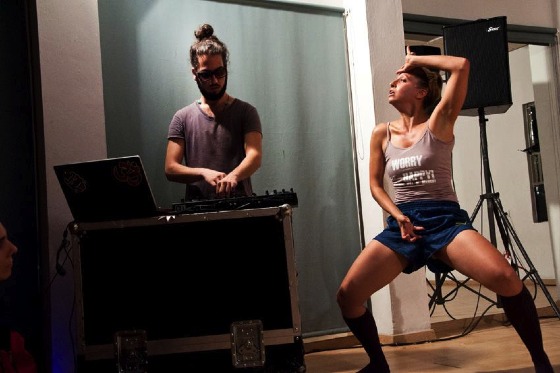
Silence by Orian Michaeli and Adi Shaul. Photo by Anat Merav.
Silence by Orian Michaeli and Adi Shaul, another duet between dancer and musician, relied on the interchanging social dynamics of formal and informal relationships. Adi Shaul’s experimental and quirky live musical mix and dancer Orian Michaeli’s sense of comic vulgarity and deadpan humor made for one of the funniest pieces of the festival. And yet another duo, the performance Clarity by Eden Wiseman and Ovi Dvir, relied heavily on one another to build a palpable tension between themselves and the unforgiving element of glass being crushed and shattered. Impermanence and vivid acts of destruction punctuated this short piece with violence and a raw sexuality.
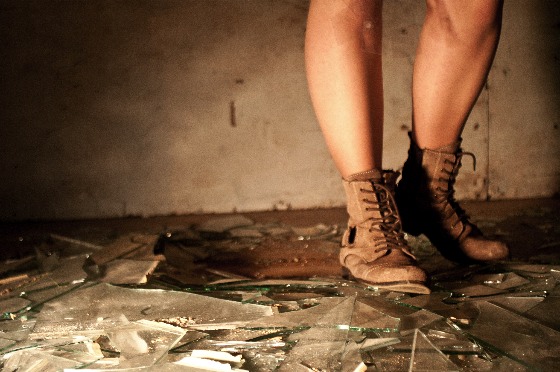
Clarity by Eden Wiseman and Ovi Dvir. Photo by Liron Narunsky.
Finally the festival’s dance offer was tempered and brought full circle by the piece BE-3, inspired by Tai Chi and choreographed by Michal Huber-Rotschild with dancers/creators Mirit Bergman, Dana Hamburger, Tal Haran and vocals by Tal Haran. It explored the delicate underpinning between three generations of women. Slow movements and well crafted choreography highlighted the eternal constellation between the three women symbolizing daughter, mother and grandmother. Their tenderness and the sincerity of their unveiled compassion for and vulnerability to each other made for an unsettling reminder of how rare these qualities are revealed in the egoism and cynicism of today’s world and contemporary art in general.
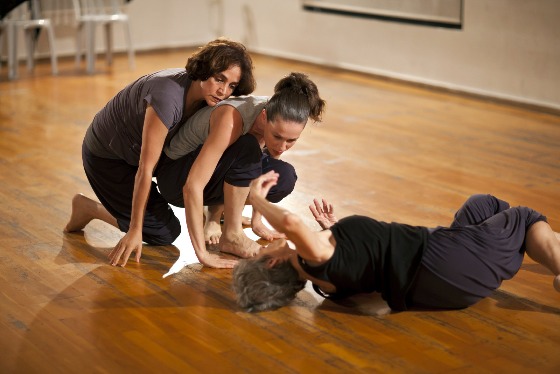
BE-3 by Michal Huber-Rotschild. Photo by Danny Berman.
Moving on to the theater works presented at this festival, the motif of the subtly and finespun power present in the relationship between women, Tova Birnnbuam’s and Rachel Gets Salomons’ That Which Is Not One metamorphosed in the two women spinning both wool and tales in several languages. A distinct counterpoint of strength and restraint between the two women and the actual wool that spread out in all directions interconnecting them with the space, gave the piece a genuine feeling of antiquity and Jewish continuity. This coupled with the absurdity and playfulness of the piece’s storytelling, mixing modern day and biblical references, made for a delightful performance.
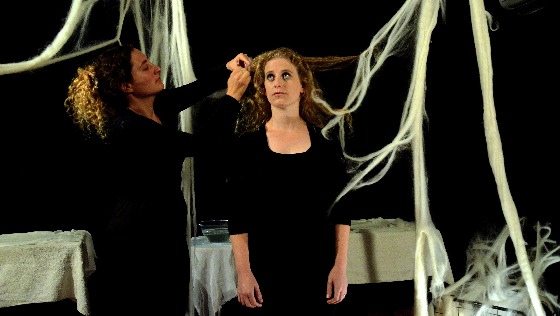
That Which Is Not One by Tova Birnbaum and Rachel Gets Salomon. Photo by Yuri Divinsky.
The play Contemporary Heart by director Avraham Simhi, who built by hand the circus-like stage set of impressive scale in the garden of Beit Tami, employed a large cast which herded and cajoled the audience, both physically and in chorus, into being avid spectators of a duel between good and evil. A severe, social satire on modern day materialism replete with a moral heroine, the comedic interruptions of a singular colorful incantation of the Furies, Greek goddesses of retribution, and the final and complete dissolution of the play’s fourth wall. It held the audience captive in a fast and furious play staged and performed with great skill in the grand tradition of Brechtian Epic Theater.
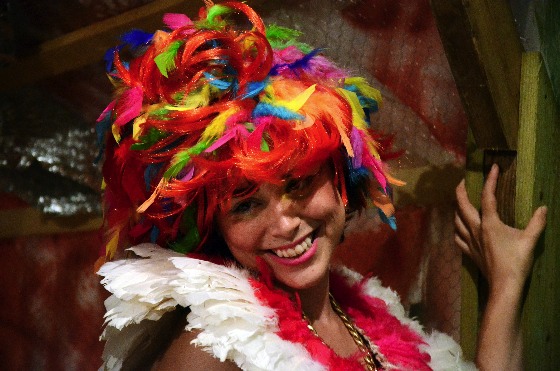
Contemporary Heart by Dir. Avraham Simhi. Photo by Yuri Divinsky.
Meredith Nadler is a Berlin based writer, critic, artist and choreographer. For more about her work, see YouTube videos http://www.youtube.com/watch?v=Z6I_4QBNd0I and http://www.youtube.com/watch?v=TyFRyfpGbY8.
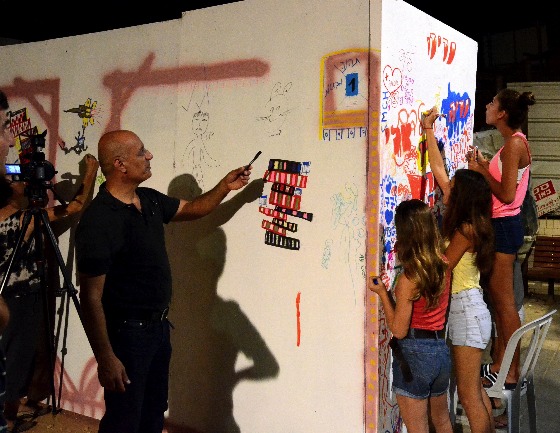
One thought on “Testing Tools 2012 at the Shenkin Garden and Beit Tami, August 7-9”
Very creative combination of dance and music. I like when there is a story behind the performance not just – simply dancing.